Moisture in the room leads to the fact that the lining on the walls and ceiling can turn blue, and direct sunlight causes darkening of certain areas. To avoid this color change, it is necessary to paint the finishing panels. After changing furniture and style, the natural color of the wood paneling may not be in harmony with the interior, so you have to change the color of the finish. Painting the lining in the country house and in a private mansion becomes an option to change the decoration of the room, to bring novelty to the appearance of the room.
The need to paint the lining inside the house
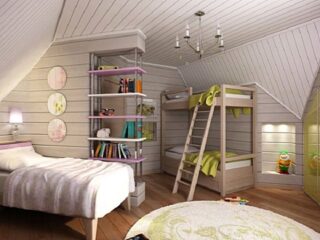
Natural wood quickly loses its properties, since a gentle microclimate is not always maintained in the house.
Reasons for changing conditions:
- insufficient foundation insulation and damp walls;
- poorly organized ventilation;
- sunny side of the room or, conversely, insufficient insolation.
The lining of the highest quality does not have pronounced knots, chips, but this variety is expensive, therefore the category of a lower class is used. Sealing cracks, filling holes from fallen knots with putty lead to the fact that white spots remain after processing. Such areas need to be painted over to hide them on the surface of the wall.
The lining is protected from negative factors:
- The action of ultraviolet rays. If the sun regularly shines on certain areas of the wall, such areas differ in shade. As a result, the wall looks old and unkempt.
- Color change due to high humidity. Often the areas in which the weakened action of the ventilation system is observed turn blue, rot and mold develop there.
- Change in structure. Insect pests grind the fibers, which leads to a decrease in the strength of the wood, destruction of the outer and inner surfaces.
- The action of fire. Treatment with protective compounds will protect the casing material from rapid ignition and flame spread.
To avoid such troubles, you need to paint the lining inside the house, to protect the surface from changing its appearance.
Selection of the necessary materials
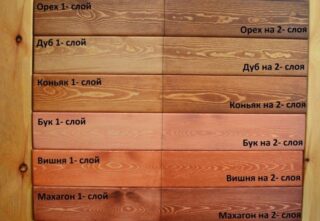
The choice of means depends on the expectation of the final result. The new decoration on the walls is treated with protective compounds to prevent fire, discoloration, destruction. Paints and varnishes are used to change the color of the walls, hide the sealing of cracks, chips, knots.
There are preparations for a more vivid expression of the wood-fiber structure. Rosewood, larch, walnut, Karelian birch are distinguished by their original pattern, which must be preserved and enhanced. They use glaze, wax, pigmented drying oils, oils, various varnishes. As a result, the fibrous pattern becomes brighter than in the untreated form, more pigment is collected in the furrows of the texture, but not on the protruding parts. The technique is called texturing or brushing the lining. Painted wood looks attractive on ceilings and vertical surfaces.
For humid operating conditions in unheated rooms, on verandas, terraces, treatment with means to increase moisture resistance is needed. Only after that varnish is applied, painted or decorated with certain techniques. Some types of wood require reapplication of the preservative.
Places of cuts are also subject to processing. During installation, the lining is formed to size, so freshly cut ends remain. You can install the board in the installation position immediately after processing, without waiting for drying.
Protective compounds
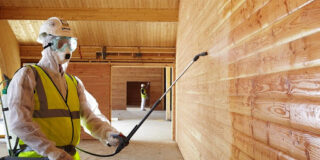
Means are divided into impregnations for internal and external use. Outdoor compounds have a wider range of protective characteristics, include chemical components harmful to the body, are more expensive, so it makes no sense to use them indoors.
Varieties of protective equipment:
- Oils for wood surfaces. Available completely transparent or with pigment. The product does not create films on wood, but is absorbed into fibrous structures. The composition protects against the absorption of dirt, abrasion. The result is a matte surface without pronounced gloss, the layer simultaneously protects and emphasizes the pattern.
- Wax formulations. Available in solid, liquid and water-based form. The latter two are ready-to-use and the solid form is warmed to soften before use. Wax protection is considered the most effective against moisture absorption, dampness and microorganisms. The disadvantage is that you have to work hard to apply an even coat.
- Antiseptics for wood. Before painting the lining inside the house, in the country, you need to use impregnation to increase the positive characteristics of wood sheathing. Preparations for processing are oil (outdoor work), fire retardants (protection against fire), water-soluble impregnation against fungal attack.
Antiseptic preparations based on organic solvents form a strong, high-density film with a long service life on the boards. Combined options are produced that simultaneously protect against moisture, combustion, microorganisms, and burnout.
Decorative means
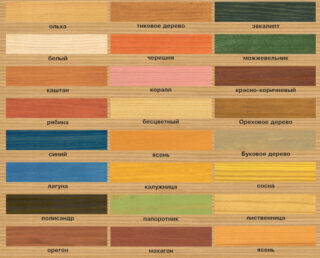
The compositions cover the wood pattern, change the color of the surface, they are chosen for decoration, hide old darkened surfaces.
For internal operations use:
- Toning stains. Impregnations do not paint over the fibrous texture, but make it pronounced and bright. On the surface of the boards, stains do not create an impermeable film, so the wood, after processing, continues to let through vapors. Compositions are weakly or strongly pigmented, they are applied one or more times, depending on the result obtained.
- Oil paints. They form a moisture-proof dense film that perfectly resists negative factors of influence. The layer closes the pores, the wood does not let steam through. The disadvantage is an unpleasant odor that disappears as it dries (24 hours). Over time, the shine fades, the brightness of the paint becomes less.
- Acrylic paints. Dries quickly, do not have a pungent odor. On the basis they are stored for a long time, practically do not fade. Acrylic compounds penetrate deeply into the wood structure, but the vapor permeability of the finish is preserved, while the layer is plastic, it does not crack when the wood shrinks.
Varnishes are produced on oil and water bases. The first ones are used more for external processing, and matte, glossy and semi-matte aqualaks are used to paint the Euro lining inside the house. Aqueous formulations do not create a dense film on the surface, but they repel dirt. Ultraviolet filters, bactericidal additives are added to varnishes.
Coverage selection rules
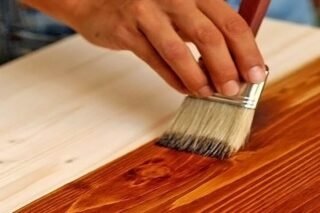
In dry rooms at home, any type of paint is used, while the compositions are selected in accordance with the requirements of decorativeness. If the lining is dried, it can not be treated with protective agents, but only paints can be used. This finish is covered with the composition on one side, while the other is left intact. When choosing a color, take into account that light tones enlarge the room, and dark tones reduce it.
Color recommendations:
- Natural wood is suitable for the living room, therefore, varnishes, wax impregnations, low-pigmented products are used to get walls with a honey-golden hue.
- The kitchen room requires calm shades of a warm direction, for example, peach, muted yellow, light orange, pale pink, oil and acrylic paints with a high degree of protection are used.
- For the study, cold and restrained tones are used, stains, varnishes, wax impregnations are used.
- The children's room is decorated depending on the age, gender of the child, water-based formulations are used, classified as environmentally friendly materials.
The bedroom also does not need brightness, causing colors. The room is covered with light-colored paint, delicate light green, beige, gray-blue tones are used.
Preparatory work

It is better to paint the lining before installation in order to properly treat the surface with protective or decorative compounds. If necessary, you can paint certain points at which the layer was damaged during the installation process.
Boards that are already installed on the wall or ceiling are painted without dismantling.
The surface of the boards is carefully sanded to an even surface. If individual lamellas are processed, use a sander. Boards mounted on a wall or ceiling are sanded with a device on level areas, and the grooves are passed with sandpaper, which is fixed on a special machine.
With the manual method, they make circular movements in different directions. Coarse grain is not used, choose sanding paper No. 180 - 280. The size depends on the existing coating on the surface, for example, there may be a varnish that is difficult to grind by hand.
An antiseptic or protective impregnation is applied with a brush before painting, trying to capture all the cavities so that there are no untreated stripes left.
If the surface has already been painted and you only need to update the shade, no sanding is done. Sometimes it is necessary to apply several coats to recolor an old color.
DIY painting features
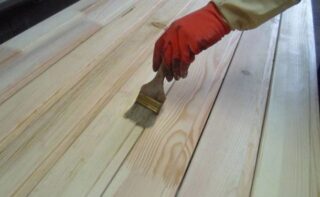
A roller is used for painting, and difficult places are passed with a brush. If oil formulations are used, the foam nozzle should not be used, since the material will corrode, exfoliated particles will stick to the surface.
Lining painting rules:
- A small amount of paint is collected on the brush, applied with strokes along the entire length of the board, then shaded and rubbed until smooth.
- The first layer is left to dry, then painted a second time.
- The varnish in the process of drying raises the villi, so an intermediate surface sanding is required.
- Primers are applied in a bold layer, a lot of funds are collected on the brush, the rule applies to those impregnations in which there is no pigment.
Sometimes, with careful shading, spots, unevenly colored areas are still visible. This is explained by the fact that the surface of the wood can absorb the composition unevenly. Boards are pre-primed in order to equalize the properties of all areas, to obtain a layer of the same quality.
Woodworking compounds are used for preliminary priming; water-based matt transparent varnishes can be used. After applying the primer, the surface is also sanded, then painted the required number of times.
High quality is obtained if the stain is consistently applied, then primed a couple of times. After that, sanding with No. 280 emery is done, then No. 320 is used. The dust is removed, then a layer of varnish is applied at a time or two.








